While most gardeners focus on fertilizer and watering schedules, the secret to vibrant plants often lies in your soil’s drainage capacity. You’ll notice dramatic improvements in root health when you maintain the right balance of air pockets and moisture retention in your potting mix. The difference between struggling and thriving plants can be as simple as adding the correct ratio of drainage materials – but you’ll need to know exactly which amendments work best for your specific plants.
Contents
Add Perlite for Aeration
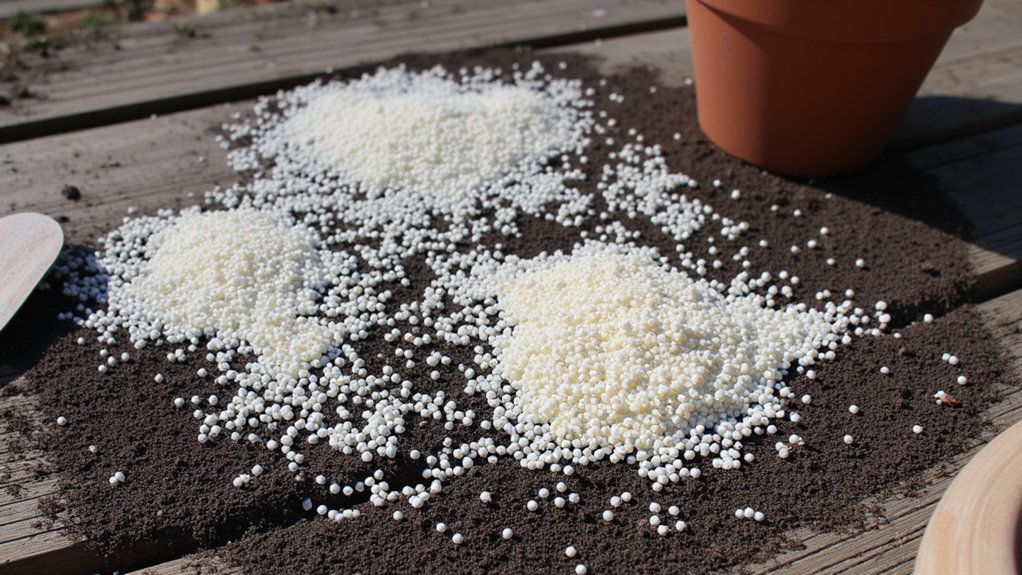
One of the most effective ways to improve soil drainage is by incorporating perlite, those small white volcanic glass particles you’ll spot in quality potting mixes. You’ll want to add 1 part perlite to every 3-4 parts of potting soil, mixing thoroughly until evenly distributed.
When you’re adding perlite to existing potted plants, carefully remove about one-third of the old soil and blend it with the appropriate amount of perlite before returning it to the pot. For new plantings, simply mix the perlite into your potting medium before filling containers.
Don’t worry if some perlite floats to the surface during watering – that’s normal. The particles will settle back into place, creating permanent air pockets that’ll prevent soil compaction and promote healthy root development throughout your plant’s life cycle.
Mix in Coarse Sand
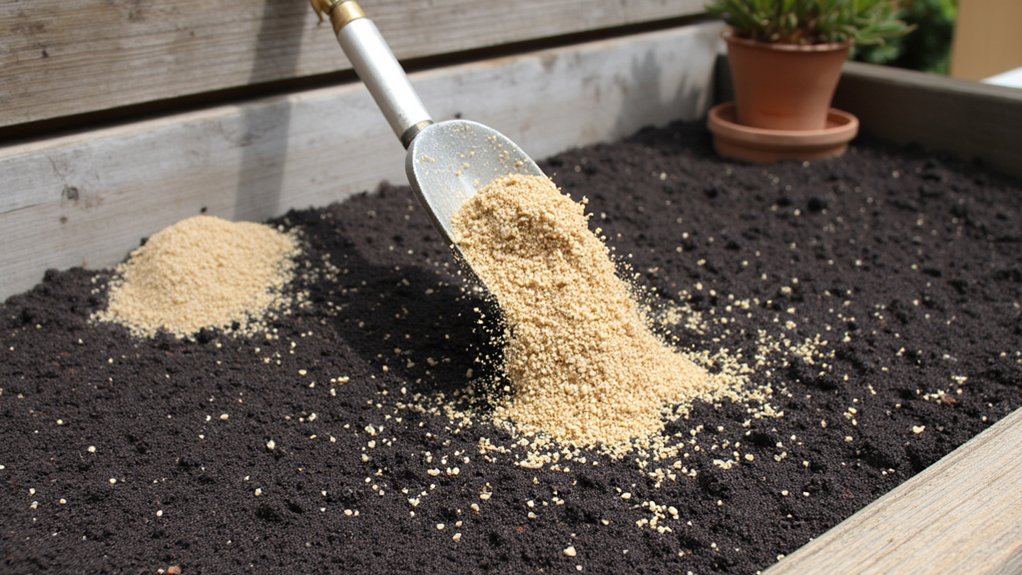
While perlite creates essential air pockets, coarse sand offers another reliable way to enhance drainage in potting soil. You’ll want to specifically use builder’s sand or horticultural sand, which has larger particles than play sand or beach sand. Mix one part coarse sand to three parts potting soil for most applications.
For container plants that need exceptional drainage, like succulents and cacti, you can increase the ratio to one part sand for every two parts soil. Be sure to thoroughly combine the materials, breaking up any clumps with your hands or a garden trowel. If you’re working with wet soil, let it dry completely before mixing in the sand to prevent compaction.
Remember to avoid fine sand, as it’ll actually decrease drainage by filling the spaces between soil particles.
Create Gravel Drainage Layer

Adding a layer of gravel at the bottom of your containers creates an essential foundation for proper drainage. You’ll want to start with a 1 to 2-inch layer of clean, pea-sized gravel or crushed stone, spreading it evenly across the container’s base.
Before adding the gravel, make sure your pot has adequate drainage holes – at least one 1/2-inch hole for every 6 inches of pot diameter. Place a piece of mesh screen or coffee filter over the holes to prevent soil from washing through while allowing water to escape freely.
Pour the gravel carefully to maintain an even distribution, then gently tap the container on a firm surface to settle the stones. This drainage layer will create air pockets that help prevent water from pooling at the bottom, reducing the risk of root rot and fungal diseases.
Add Bark Chips
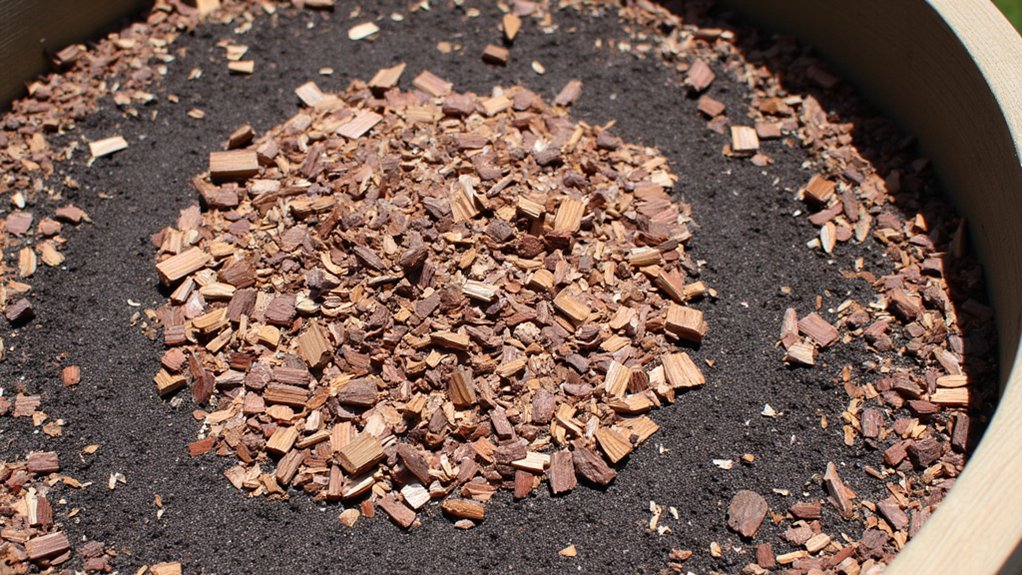
Bark chips serve as an excellent organic amendment to improve drainage and aeration in potting soil. Mix in pine, fir, or cedar bark chips that are roughly 1/4 to 1/2 inch in size, incorporating them at a ratio of one part bark to three parts soil. You’ll notice these chips create essential air pockets that prevent soil compaction.
When adding bark chips, start by spreading your existing potting soil on a tarp or large container. Gradually mix in the bark chips using your hands or a small trowel, ensuring even distribution throughout. For best results, you’ll want to break up any clumps larger than a quarter.
Remember to avoid using fresh bark chips, as they can temporarily deplete nitrogen from your soil. Instead, opt for aged or composted bark that’s been weathered for at least six months.
Add Pumice Stone
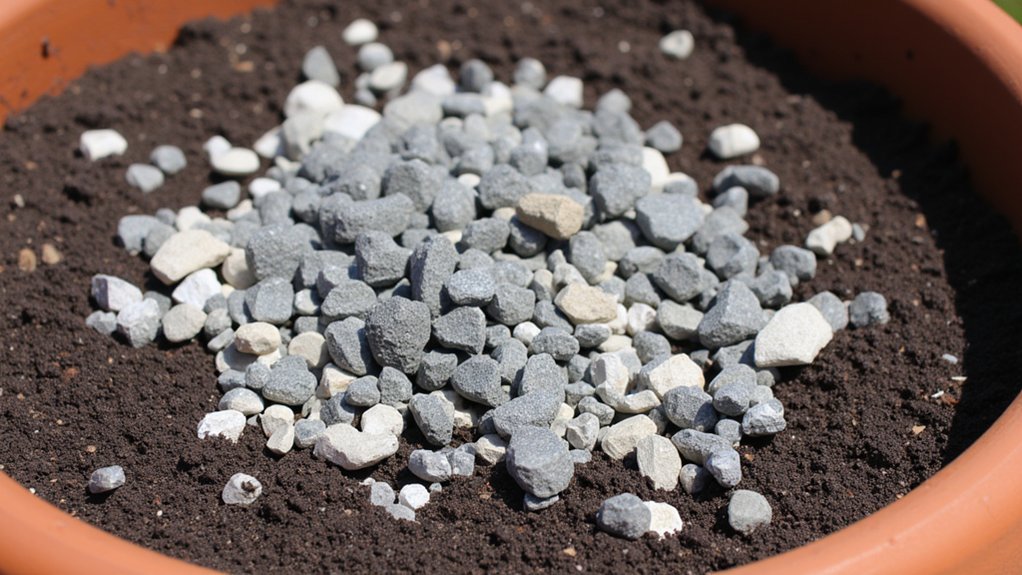
Pumice stone offers another powerful way to enhance soil drainage, working alongside organic materials like bark chips to create an ideal growing environment. This lightweight, porous volcanic rock creates permanent air pockets in your soil mix, preventing compaction while improving both drainage and aeration.
To incorporate pumice, mix it into your potting soil at a ratio of 1:4 (one part pumice to four parts soil). You’ll want to use 1/4 inch particles for most container plants, though you can opt for 1/8 inch pieces when working with smaller pots or seedlings.
Unlike organic amendments that break down over time, pumice stone maintains its structure indefinitely. It’s also sterile and pH neutral, making it an excellent choice for both acid-loving and alkaline-preferring plants, while helping prevent root rot and fungal issues.
Add Coco Coir Fibers
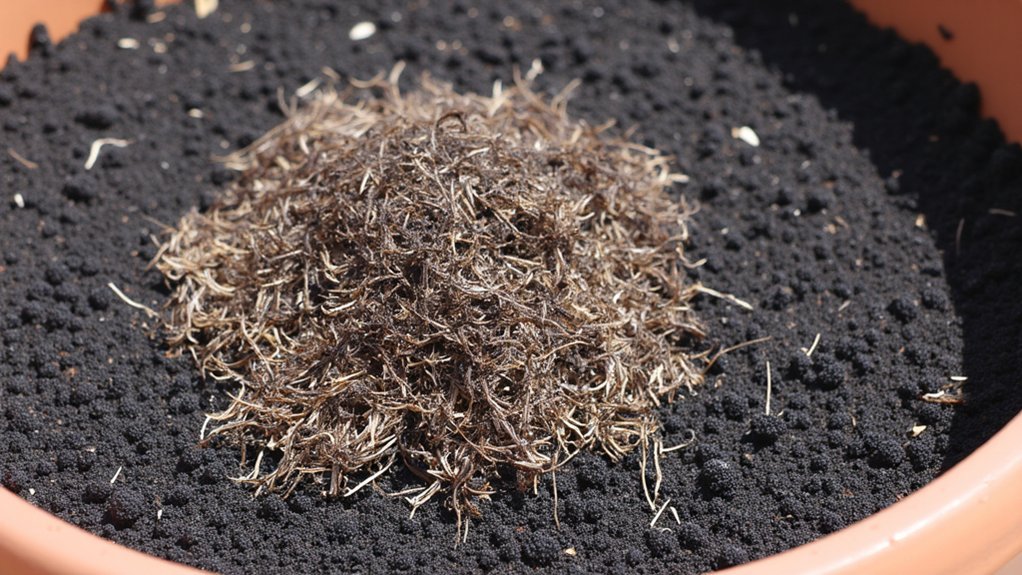
The sustainable coco coir fiber represents one of today’s most effective drainage amendments for potting soil. Made from coconut husks, these brown, fibrous strands create essential air pockets while retaining just the right amount of moisture for healthy root development.
To incorporate coco coir, you’ll want to mix it at a ratio of 1:3 with your existing potting soil. First, break up any compressed coir bricks by soaking them in water for 15 minutes, then drain excess moisture. Mix the loosened fibers thoroughly into your soil, ensuring even distribution throughout.
Unlike peat moss, coco coir’s neutral pH won’t affect your soil’s acidity levels, and it’s naturally resistant to fungal growth. The fibers also decompose slowly, maintaining their structural integrity for up to three years in your potting mix.
Add Crushed Pine Needles
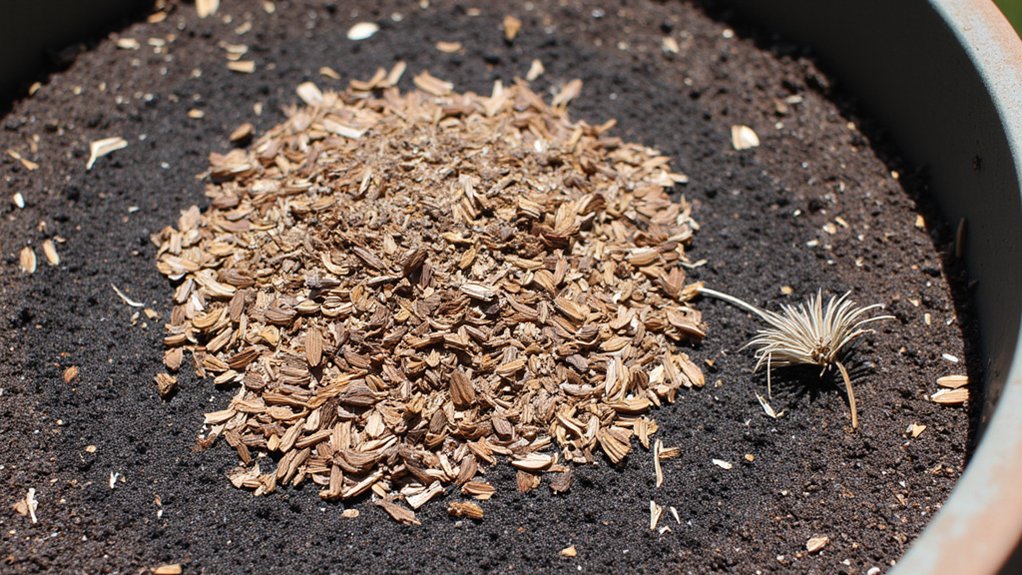
Pine needles provide a natural and renewable drainage solution when crushed into pieces measuring 1/2 to 1 inch in length. You’ll want to gather fallen needles from beneath pine trees, ensuring they’re dry and free from debris before crushing them.
Mix the crushed pine needles into your potting soil at a ratio of 1:4 (one part needles to four parts soil). The needles’ waxy coating and rigid structure create lasting air pockets that prevent soil compaction while slowly decomposing to add beneficial acids to the mix.
You can store excess crushed pine needles in a dry container for up to six months. Just remember to check for mold before using stored needles, and don’t use needles that have been treated with pesticides or collected from roadsides.
Add Activated Charcoal

Adding activated charcoal to your potting mix creates a powerful filtration system that prevents bacteria and fungi from overwhelming plant roots. You’ll want to use about one tablespoon of activated charcoal per quart of potting soil, mixing it thoroughly throughout the medium.
The charcoal’s porous nature helps trap excess minerals and chemicals that can build up in your soil over time. When you’re preparing the mixture, crush any large pieces to roughly pea-size to maximize their effectiveness.
For best results, layer the charcoal about 1-2 inches from the bottom of your pot, then add a mix of the remaining charcoal and soil above it. This arrangement helps create ideal drainage zones while maintaining the charcoal’s purifying properties throughout the pot’s entire depth.
Add Gypsum Powder
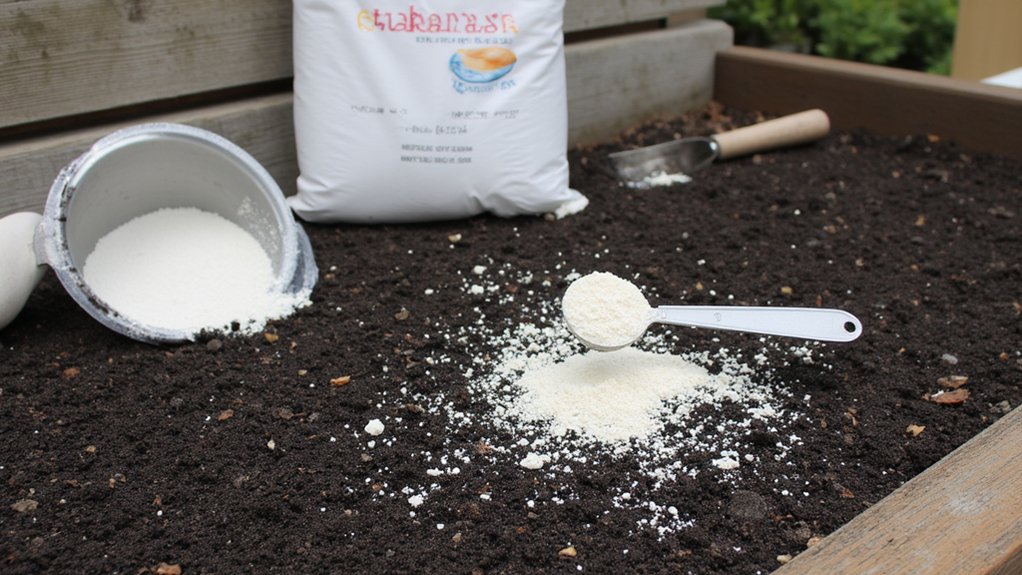
Generous amounts of gypsum powder can greatly improve your soil’s structure and drainage capabilities. For every gallon of potting soil, mix in 2-3 tablespoons of gypsum powder, working it thoroughly through the mixture with your hands or a small trowel.
You’ll find that gypsum’s calcium sulfate content helps break up compacted soil while creating tiny channels for water movement. It’s particularly effective when you’re dealing with clay-heavy potting mixes that tend to retain too much moisture.
For best results, incorporate the gypsum powder when you’re first preparing your potting mix, rather than adding it later. If you’re treating existing potted plants, carefully work small amounts into the top 2-3 inches of soil, being mindful not to disturb the root system.
Mix in Worm Castings
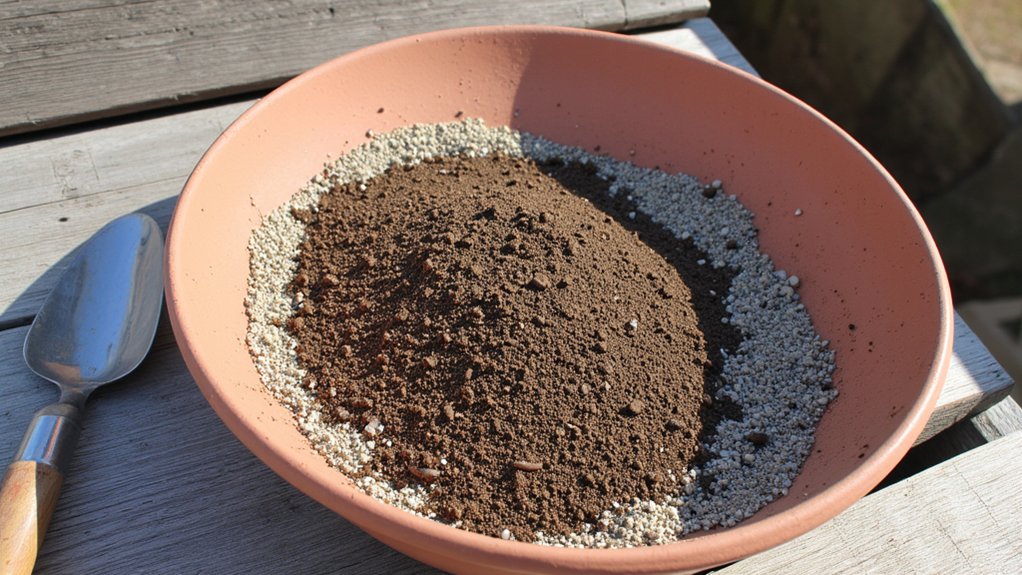
While traditional soil amendments focus on texture, worm castings offer a unique combination of drainage enhancement and nutrient delivery. These nutrient-rich pellets create tiny air pockets in your potting mix while slowly releasing essential minerals and beneficial microorganisms.
Add one part worm castings to every four parts of potting soil, mixing thoroughly until you’ve achieved a consistent blend. You’ll notice the soil becoming lighter and more friable as you work the castings through the mix.
For container plants, you can also create drainage-boosting layers by adding a 1-inch band of pure worm castings about halfway up your pot. This technique helps prevent water from pooling around your plant’s roots while providing a steady supply of nutrients throughout the growing season.
